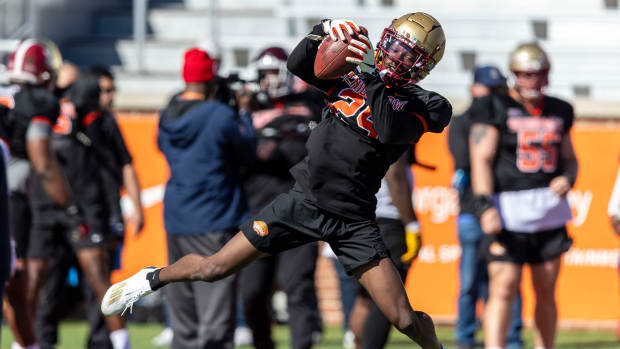Colts' Run Game Finds New Path for Success vs. Raiders
The Indianapolis Colts bested the Las Vegas Raiders 23-20 on Sunday to move to 9-7 on the season. The Colts have just one more game between them and a spot in the 2023 NFL playoffs.
The Colts' offense propelled them to victory in this outing, as they averaged nearly 10 yards per pass attempt and 4.6 yards per rush against a strong Raiders' defense. The Raiders came into this game as the best defense in football since week nine, but that was no issue whatsoever for Shane Steichen and the Colts' offense.
One of the biggest contributing factors to the Colts' success on offense was their run game. The Raiders came into this game allowing just 3.14 yards per carry to running backs in the three games prior to this Colts' match-up. The Colts, however, were able to explode for 131 yards (4.8 yards per carry for running backs) on the ground against this stout defensive front.
How did the Colts' do it? Well, they drastically changed their rushing identity in order to counteract the Raiders' aggressiveness in the trenches.
Wham/Trap Plays
The Raiders deploy an aggressive front seven in run defense. Their defensive line, led by Maxx Crosby, shoots gaps with disruption on their mind and their linebackers are athletic run fillers with some pop in their pads.
This style of run defense poses an issue for teams like the Colts that tend to rely on inside zone runs as their primary staple on the ground. The Raiders aggressively change blocking angles in the trenches, stopping inside zone runs and duo calls with relative ease.
Luckily for the Colts, they have faced a few teams with a similar philosophy this season, one of which being the Los Angeles Rams back in week four. The Rams' aggressive front shut down the Colts' run game in the first half of that game before Indy began using that aggressiveness against them in the second half.
In this game against the Raiders, Steichen was ready from the first drive of the game. Steichen countered the Raiders' strong front seven with several wham/trap calls to get running back Jonathan Taylor going on inside runs.
This first wham design is an absolute beauty that leaves the Raiders' defensive tackle falling to the earth before the wham block even arrives. The Colts' wham design also has a cool wrinkle involved that coincides perfectly with their typical inside zone staple.
Defensive linemen nowadays are taught to feel wham blocks more than they used to. The Colts countered this adjustment by adding a zone step to the wham process from the guard over the defensive tackle being trapped. For example, Quenton Nelson (on this play below) sells a zone block with his first step before shifting out to block the defensive end.
That first step is enough to tell the defensive tackle that it is a zone run (when it's not). Once that tackle commits to the one gap, Nelson leaves him grasping for air as the wham comes inside and Taylor explodes for a big gain:
This wham design worked wonders for the Colts on Sunday, as the Raiders' front had no idea how to defend it. The Colts' offensive line was simply fantastic on this design, and tight end Mo Alie-Cox did an excellent job of washing out the defensive tackle all game long.
This run below is a teach tape on how to execute a wham call. Every block is perfect across the line and Taylor is able to burst through the hole untouched for a big chunk gain.
The Colts also mixed in a few tackle traps and other runs of the sort to keep the Raiders' defensive front honest. These runs didn't become their staple by any means, but they were used in key situations when the Colts' knew the defense would be firing off of the ball.
This clip below was on a key short yardage play in the second half. Bernhard Raimann trapped the defensive tackle on the interior to free up Taylor for another solid gain.
Mixing In Outside Runs
The Colts utilized trap and wham runs to keep the Raiders' defensive line honest, but they still had to deal with the Raiders' fast linebackers firing downhill on inside runs. One way to keep that position group honest is to attack the edges of the defense.
The Colts typically keep their runs contained more to the inside (behind Nelson and center Ryan Kelly), but they decided to mix in a few toss plays to the edge in this game. This strategy paid massive dividends, as both Taylor and backup running back Trey Sermon were able to break off massive gains on these runs.
While the Colts' play-callers deserve credit for this change-up added to the gameplan, the entire Colts' offense deserves even more credit for executing. Wide receivers D.J. Montgomery and Michael Pittman Jr. hit key blocks to spring these two runs, respectively. Alie-Cox and Kylen Granson also did their parts on the outside as well on these runs.
The Bottom Line
The Colts' run game lives and dies by it's inside zone run staple, but the team has shown a willingness to mix in some change-ups depending on the match-up. The Raiders brought an aggressive, gap shooting mindset into this game and the Colts' countered with several well-timed wham/trap calls.
These are the little things that show just how well coached the Colts are on offense. They are an adaptive group that understands how to create solutions to the problems that defenses present to them. The Colts' offensive coaching staff, led by Steichen, is one of the main reasons why Indy is in this potential playoff situation just one year removed from the disastrous 2022 campaign.
Need your fill on daily Colts' content? Head over to the Locked On Colts' YouTube channel where Jake Arthur and I hit on all the major topics surrounding this team. Hit that subscribe button while you are there!
Follow Horseshoe Huddle on Twitter and Facebook.
Subscribe to Horseshoe Huddle on YouTube for daily Colts live-stream podcasts!







